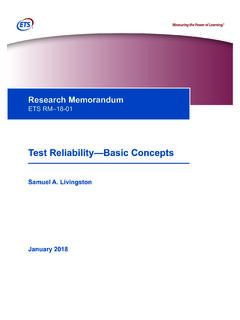Transcription of Python Penetration Testing - Tutorialspoint
1 Python Penetration Testing i Python Penetration Testing i About the Tutorial Penetration Testing (Pen Testing ) is an attempt to evaluate the security of an IT infrastructure by simulating a cyber-attack against computer system to exploit vulnerabilities. It helps an organization strengthen its defenses against cyber-attacks by identifying vulnerabilities. Audience This tutorial will be useful for graduates, postgraduates, and research students who either have an interest in this subject or have this subject as part of their curriculum. The reader can be a beginner or an advanced learner. Prerequisites The reader must have basic knowledge about Testing , Operating System, and Computer Networks. He/she should also be aware about basic Python programming concepts. Copyright & Disclaimer Copyright 2018 by Tutorials Point (I) Pvt.
2 Ltd. All the content and graphics published in this e-book are the property of Tutorials Point (I) Pvt. Ltd. The user of this e-book is prohibited to reuse, retain, copy, distribute or republish any contents or a part of contents of this e-book in any manner without written consent of the publisher. We strive to update the contents of our website and tutorials as timely and as precisely as possible, however, the contents may contain inaccuracies or errors. Tutorials Point (I) Pvt. Ltd. provides no guarantee regarding the accuracy, timeliness or completeness of our website or its contents including this tutorial. If you discover any errors on our website or in this tutorial, please notify us at Python Penetration Testing ii Table of Contents About the Tutorial .. i Audience .. i Prerequisites .. i Copyright & Disclaimer .. i Table of Contents.
3 Ii 1. Python Penetration Testing Introduction .. 1 Significance of Penetration (pen) Testing .. 1 Who is a good pen tester? .. 2 Penetration Testing Scope .. 2 What to install for practice Penetration Testing ? .. 3 2. Python Penetration Testing Assessment Methodology .. 4 What is PTES? .. 4 Seven Phases of PTES .. 4 Pre-engagement Interactions Phase .. 5 Intelligence Gathering Phase .. 6 Threat Modeling 6 Vulnerability Analysis Phase .. 8 Active Testing .. 8 Passive Testing .. 8 Validation .. 9 Research .. 9 Exploitation Phase .. 9 Post Exploitation Phase .. 10 Reporting .. 10 3. Python Penetration Testing A Primer on Network Communication .. 13 Reference Model .. 13 Python Penetration Testing iii OSI Model .. 14 TCP/IP Model .. 15 Useful 17 Extended Ethernet Frame (Ethernet II frame) Format .. 18 The IP Packet Architecture .. 19 IPv4 .. 19 IPv6 .. 21 The TCP (Transmission Control Protocol) Header Architecture.
4 23 The UDP (User Datagram Protocol) header architecture .. 25 4. Python Penetration Testing The Socket and its Methods .. 27 Python s Socket Module for Socket Programming .. 27 Socket Methods .. 28 Program to establish a connection between server & client .. 29 5. Python Penetration Testing Python Network Scanner .. 32 Port Scanner using Socket .. 32 Port Scanner using ICMP (Live hosts in a network) .. 33 Concept of Ping Sweep .. 34 Port Scanner using TCP scan .. 35 Threaded Port Scanner for increasing efficiency .. 37 6. Python Penetration Testing Network Packet Sniffing .. 39 What can be sniffed? .. 39 How does sniffing work? .. 39 Types of Sniffing .. 40 The Sniffing Effects on Protocols .. 40 Implementation using Python .. 41 7. Python Penetration Testing ARP Spoofing .. 43 Working of 43 What is ARP Spoofing? .. 43 Python Penetration Testing iv Implementation using Python .
5 43 Implementation using Scapy on Kali Linux .. 45 8. Python Penetration Testing Pentesting of Wireless Network .. 47 Important Terminologies .. 47 Communication between client and the wireless system .. 47 The Beacon Frame .. 48 Finding Wireless Service Set Identifier (SSID) using Python .. 49 Detecting Access Point Clients .. 51 Wireless Attacks .. 51 9. Python Penetration Testing Application Layer .. 55 Foot printing of a web server .. 55 Methods for footprinting of a web server .. 55 Footprinting of a Web Application .. 58 Methods for Footprinting of a Web Application .. 58 10. Python Penetration Testing Client-side Validation .. 60 Server-side Validation & Client-side Validation .. 60 Tempering Client-side Parameter: Validation Bypass .. 60 Python Module for Validation Bypass .. 60 11. Python Penetration Testing DoS & DDoS attack .. 62 DoS (Denial-of-Service) Attack.
6 62 Types of DoS Attack & its Python Implementation .. 62 DDoS (Distributed Denial-of-Service) Attack .. 65 12. Python Penetration Testing SQLi Web Attack .. 67 Types of SQLi Attack .. 67 13. Python Penetration Testing XSS Web Attack .. 70 Types of XSS Attack .. 70 Python Penetration Testing 1 Pen test or Penetration Testing , may be defined as an attempt to evaluate the security of an IT infrastructure by simulating a cyber-attack against computer system to exploit vulnerabilities. What is the difference between vulnerability scanning and Penetration Testing ? Vulnerability scanning simply identifies the noted vulnerabilities and Penetration Testing , as told earlier, is an attempt to exploit vulnerabilities. Penetration Testing helps to determine whether unauthorized access or any other malicious activity is possible in the system.
7 We can perform Penetration Testing for servers, web applications, wireless networks, mobile devices and any other potential point of exposure using manual or automated technologies. Because of Penetration Testing , if we exploit any kind of vulnerabilities, the same must be forwarded to the IT and the network system manager to reach a strategic conclusion. Significance of Penetration (pen) Testing In this section, we will learn about the significance of Penetration Testing . Consider the following points to know about the significance: Security of organization The significance of Penetration Testing can be understood from the point that it provides assurance to the organization with a detailed assessment of the security of that organization. Protecting confidentiality of organization With the help of Penetration Testing , we can spot potential threats before facing any damage and protect confidentiality of that organization.
8 Implementation of security policies Penetration Testing can ensure us regarding the implementation of security policy in an organization. Managing network efficiency With the help of Penetration Testing , the efficiency of network can be managed. It can scrutinize the security of devices like firewalls, routers, etc. ensure organization s safety Suppose if we want to implement any change in network design or update the software, hardware, etc. then Penetration Testing ensures the safety of organization against any kind of vulnerability. 1. Python Penetration Testing Introduction Python Penetration Testing 2 Who is a good pen tester? Penetration testers are software professionals who help organizations strengthen their defenses against cyber-attacks by identifying vulnerabilities. A Penetration tester can use manual techniques or automated tools for Testing .
9 Let us now consider the following important characteristics of a good Penetration tester: Knowledge of networking and application development A good pentester must have knowledge of application development, database administration and networking because he/she will be expected to deal with configuration settings as well as coding. Outstanding thinker Pentester must be an outstanding thinker and will not hesitate to apply different tools and methodologies on a particular assignment for getting the best output. Knowledge of procedure A good pentester must have the knowledge to establish the scope for each Penetration test such as its objectives, limitations and the justification of procedures. Up-to-date in technology A pentester must be up-to-date in his/her technological skills because there can be any change in technology anytime. Skillful in report making After successfully implementing Penetration Testing , a pen tester must mention all the findings and potential risks in the final report.
10 Hence, he/she must have good skills of report making. Passionate about cyber security A passionate person can achieve success in life. Similarly, if a person is passionate about cyber securities then he/she can become a good pen tester. Penetration Testing Scope We will now learn about the scope of Penetration Testing . The following two kinds of tests can define the scope of Penetration Testing : Nondestructive Testing (NDT) Nondestructive Testing does not put the system into any kind of risk. NDT is used to find defects, before they become dangerous, without harming the system, object, etc. While doing Penetration Testing , NDT performs the following actions: Python Penetration Testing 3 Scanning of remote systems This test scans and identifies the remote system for possible vulnerabilities. Verification After finding vulnerabilities, it also does the verification of all that is found.
















